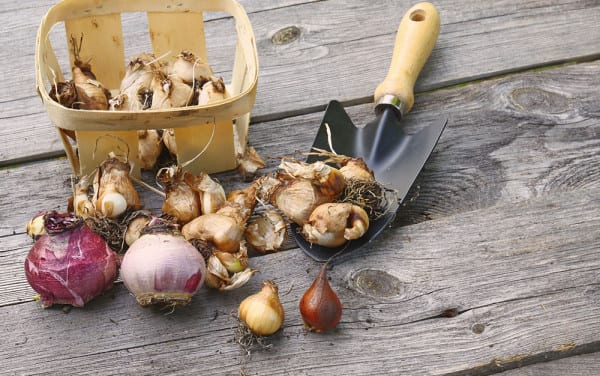Autumn is usually the time of year when bulbs appear in the shops and online for sale for planting between now and the end of the year. This month is the time to be planting out corms, so here’s how to do it…
What’s the difference?
Quite often the term ‘bulb’ is used to collectively describe bulbs, corms, tubers, and rhizomes. They all do the same thing; store food for the plant to use when it starts to grow. But in reality, there are some major differences.
Bulbs have many fleshy layers inside with a miniature flower in the middle. A good example is a daffodil.
Corms have a more solid feeling exterior and no internal fleshy layers. Unlike a bulb, after flowering, a corm is completely empty. However, during its growth cycle, it forms a completely new corm on top of the old one to replace it. Crocuses grow from corms.
Tubers have growing points all over it, all of which can grow into roots or shoots. Potato is a great example of a tuber.
On the other hand, a tuberous root starts life as a swollen root that can only grow from one end, like dahlias.
Rhizomes are a fleshy underground stem that grows horizontally, either underground or at ground level. Like tubers, these have many growing points. Bearded irises are grown from rhizomes.

Growing corms
Corms are like bulbs in that they do best if grown in nutrient-rich, well-drained soil. Most prefer a sunny spot.
When planting make sure you place them in the soil at about 3 times the depth of the corm with the pointed side upwards.
Since the corm creates entirely new corms on top of the original one each growing season it’s a good idea to dig up the clumps during the winter, separate out the old corms and save the newer, healthy ones for replanting.
Examples of corms are crocus, gladioli, freesia, and ranunculus.

Planting in pots
When planting in pots, use peat-free, free-draining compost with a handful of grit mixed in. This will give the added bonus of being able to move the container when in flower to jazz up a flower border. Also, some corms, like crocosmia, can multiply very quickly and so growing in pots means their spread can be contained if space in the garden is limited.
Planting in grass
Naturalising corms like crocus in a lawn can be a lovely way of adding spring colour to the garden, especially if your flower borders are already full of other plants.
A fun way of creating a natural look when planting in the lawn is to gently throw the bulbs, planting them in the grass where they land.
Use a strong hand trowel or bulb planter to plant into the grass, digging the hole to the recommended planting depth on the packet and making sure the corm is facing the right way up. Cover the corm with soil, gently firming around and on top of it to remove any air pockets. Replace the loosened grass over the top to avoid weed seeds germinating.
If you want to plant a large number of corms, it might be easier to lift large sections of turf with a spade and replace after planting.

What to do after flowering
Most corms can be left in the ground after flowering. Some, like gladioli, benefit from being lifted once the foliage has died back. Discard the old corms and store healthy new corms in a frost-free, dry environment out of direct light until spring when they can be re-planted.
If keeping in the ground it’s a good idea to cover the soil above them with a thick winter mulch such as fallen leaves, leaf mould or well-rotted compost. This will also help keep moisture in the soil and suppress weeds.
Ranunculus need to be kept fairly dry during their dormant stage so it might be best to lift these, cut off the dead foliage, spread out to dry for a few days before storing, avoiding plastic as this may encourage rot.


Leave A Comment